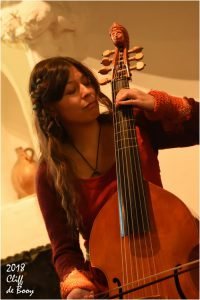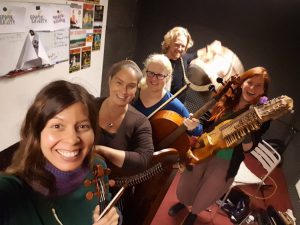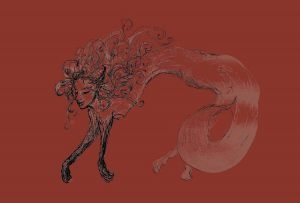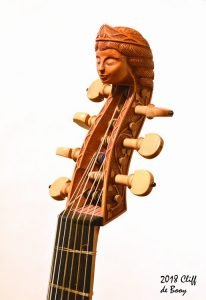
The autumn queen came home again,
she flew with geese by starlight.
Acorn and chestnut called her name,
as did rain and flame and twilight.
This is part of the poem The Autumn Queen which opens Meidi Goh‘s first solo EP Heartstrings. Meidi wrote the poem herself and to her it is a portal into her work, her music. After some years studying classical and baroque violin, Meidi started playing with the baroque ensemble Kolibrie. After that she joined the Dutch jazzy folk band AmmA. The last year Meidi devided her attention between the Dutch historic folk band Imbue and her first solo album.
“After many years in bands I wanted to share my own musical ideas and my own personal stories.” Meidi told me: “This is how Heartstrings was born. I wanted to make music that was a bridge between Elisabethan baroque music and folk. I wanted it to have as pure a sound as possible. I wanted the listener to hear every stroke of the bow over the strings we played. I also wanted the music and my voice to sound as honest as possible. With my perfections but also imperfections, everything as pure as possible. The lyrics straight from my heart, hence the title Heartstrings.” Well I can tell you, she absolutely achieved that.
 Heartstrings contains 7 tracks, one poem, one traditional, two covers and 3 original compositions written by herself.
Heartstrings contains 7 tracks, one poem, one traditional, two covers and 3 original compositions written by herself.Lovelorn is the first of Meidi’s own compositions and it’s a beautiful ballad. It is, obviously, a love song, a bit melancholic in text and music as most of the songs on Heartstrings. It tells about a love that is not to be. The string section in this song is already lovely, but what really jumps out are the voices. Meidi has a wonderful skilled soprano. When she goes into the heights of her voice she hits the notes perfectly in what I would call ‘classic’ soprano style, but in the lower regions she returns to her ‘normal’ voice, giving the song so much more personality. Her voice has this youthful fragility and purity that make the hairs stand up. So beautiful. From the beginning I had to think of some of the top young boy sopranos, hearing her voice. And I mean that in the most complimentary of ways.
Everybody who has seen the musical Oliver Twist for instance, will remember young Oliver singing Who Will Buy This Beautiful Morning. There is this youthful innocence when he sings that song, one we all know will disappear when he gets older that makes it so touching. Somehow Meidi managed to keep that young and pure quality in her voice, although she is an accomplished singer. And somehow Jacco de Wijs-van Gorcum has managed to capture that while recording the vocals. Of course we know him as one of the frontmen of the Dutch folk metalband Heidevolk, but here he proves he is just as talented behind the mixer. Especially in the chorus, where Hanna van Gorcum joins Meidi in a call and answer that is as pure as crystal. Stunning.
After I asked Meidi about her singing style, she explained more about it:’ When I was young I grew up with ‘old’ music. Music from the renaissance and baroque era. One of the stand out features of these periods is the different use of vibrato in the music and in the singing. A lot milder and totally different in intensity from how we use it today. In those days people were more interested in purity of sound. And indeed that is just how the boy sopranos sing. That style actually originates from this early period. the heavier use of vibrato started to appear in the 18th century, with the first operas from the classical time period which followed the baroque, and even more so in the romantic period. Hanna van Gorcum is much more classically trained. You could call my voice an ‘old’ or baroque music voice.’
 Jacco is not the only talented musician involved in Heartstrings. I already mentioned Hanna van Gorcum
(TDW & Dreamwalker inc,
former AmmA) on voice and nyckelharpa. There is also Coca Román
(Kelten Zonder Grenzen,
Violet)
on harp, Hester de Boer (Violet) on cello and quinton, -a 5 stringed violin that was build and played between early 18th century and the French revolution, you could call it a viola and a violin in one instrument-, and Imbue colleague Tim Elfring on davul. All but Tim join Meidi on the next song, Waltz For The Little Mermaid, written and partly arranged by Meidi. The other musicians where all given room to arrange their own parts on this song, giving them all a chance to shine.
Jacco is not the only talented musician involved in Heartstrings. I already mentioned Hanna van Gorcum
(TDW & Dreamwalker inc,
former AmmA) on voice and nyckelharpa. There is also Coca Román
(Kelten Zonder Grenzen,
Violet)
on harp, Hester de Boer (Violet) on cello and quinton, -a 5 stringed violin that was build and played between early 18th century and the French revolution, you could call it a viola and a violin in one instrument-, and Imbue colleague Tim Elfring on davul. All but Tim join Meidi on the next song, Waltz For The Little Mermaid, written and partly arranged by Meidi. The other musicians where all given room to arrange their own parts on this song, giving them all a chance to shine.Meidi insisted that all the songs would be recorded as an ensemble, in one take, keeping with the pure natural feel that she was after, only the vocals were recorded separately. And I can only say, it worked. The songs just sparkle. Jacco did wonders catching it all on tape, and after that, mixing engineer Fieke van den Hurk and mastering engineer Sander van der Heide made the most of all the quality that they were given.
 My favourite track on Heartstrings is another original composition, Foxskin. Balfolk people will love this song, I’m sure of it.
This cheerful fun song brings together all the elements that define Meidi Goh’s classical folk style.
It’s the perfect blend between the baroque music that she started out with and the English folk she fell in love with later on in her musical career. English because of the pronunciation of the lyrics.
It is as if
Loreena McKennitt
and
Johann Sebastian Bach
did a baroque minuet / folk CD together. Sounds odd? Maybe but believe me it so makes sense when you hear the songs. The two worlds just blend naturally together in Meidi’s compositions.
The song itself is about a young lady who, at night, turns into a fox to dance with the elves and other magical creatures in the dark woods
My favourite track on Heartstrings is another original composition, Foxskin. Balfolk people will love this song, I’m sure of it.
This cheerful fun song brings together all the elements that define Meidi Goh’s classical folk style.
It’s the perfect blend between the baroque music that she started out with and the English folk she fell in love with later on in her musical career. English because of the pronunciation of the lyrics.
It is as if
Loreena McKennitt
and
Johann Sebastian Bach
did a baroque minuet / folk CD together. Sounds odd? Maybe but believe me it so makes sense when you hear the songs. The two worlds just blend naturally together in Meidi’s compositions.
The song itself is about a young lady who, at night, turns into a fox to dance with the elves and other magical creatures in the dark woods
My Love Came To Dublin is the first cover I want to mention. It’s a song originally co-written and recorded by June Tabor. And it fits perfectly within Meidi’s own songs. I once called Gwendolyn Snowdon a storyteller, well Meidi is a poet. And her songs are poetry in music form. The Lyrics of My Love came To Dublin fit right in, with that slight old English feel. It’s a melancholic song full of longing for an absent lover. The deep sound of the seven stringed bass viol enhances that sad autumn feel and is a lovely contrast to Meidi’s angelic voice. Coca’s harp then enhances the purity of it. Again a lovely song. Recorded and mixed so well.
Konungen Och Trollkvinnan, is another cover. It was originally recorded by the Finnish folkband Gjallarhorn. As Gjallarhorn hail from the only part of Finland where Swedish is the main language Trollkvinnan is a Swedish song, based around the sound of violin and nyckelharpa, this in contrast to the other songs on Heartstrings. This reminds me more of Kaunan ‘s music or that of the Swiss duo Knep on Bestioles. A CD I reviewed a few months ago.
 The last song on Heartstrings is a traditional that goes by the name, Once I Had A Sweetheart. Hanna starts this song with a lovely nyckelharpa solo. And Meidi once again pours out her melancholic heart on the low tones of her bass viol. She sometimes affectionately calls her bass viol ‘my muse’. This Viola da gamba -the Dutch name for it- was specially made for Meidi’s mother many years ago. -Meidi herself even drew the design of the head- and her mother asked Meidi:’You will play her after I’m gone won’t you? And needless to say Meidi did just that to this very day.
The last song on Heartstrings is a traditional that goes by the name, Once I Had A Sweetheart. Hanna starts this song with a lovely nyckelharpa solo. And Meidi once again pours out her melancholic heart on the low tones of her bass viol. She sometimes affectionately calls her bass viol ‘my muse’. This Viola da gamba -the Dutch name for it- was specially made for Meidi’s mother many years ago. -Meidi herself even drew the design of the head- and her mother asked Meidi:’You will play her after I’m gone won’t you? And needless to say Meidi did just that to this very day.This is a mini CD that will appeal to open minded classical people as much as it will people that enjoy the lovely folk ballads of bands like AmmA, Anuna, and Rosemary & Garlic or the more traditional songs from Loreena McKennitt, Altan and the German band Cara, (whose new live CD I’ll be reviewing later this year) . Don’t expect fast dancing songs on Heartstrings, they are all slow to mid tempo ballads. But there are some nice balfolk dances on it. Trollkvinnan can be used for a Swedish halling, Waltz For The Little Mermaid off course is a waltz, My Love Came To Dublin is a muzarka and the most complicated one is Foxskin, this song combines a scottish with a waltz.
Meidi, together with all the talented friends that she invited to help her, has made a wonderful CD, that she can be really proud of. I have only one complaint with it. For such beautiful music, it ends way too soon. So here’s hoping that the next album will come soon, and that it will be a full length one. ‘Till then Heartstrings shall make many a turn more in my CD player.

Cliff
Editor: Diane
Picture credit:
– CD sleeve picture by Alexander Holwerda
– CD artwork by Meidi Goh
– studio photo by Meidi Goh
– live pictures by Cliff de Booy